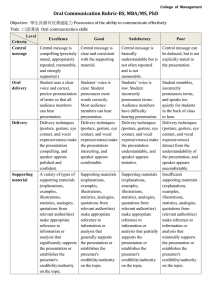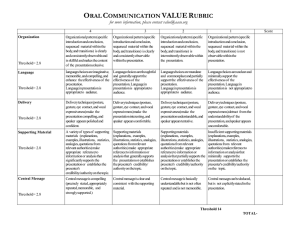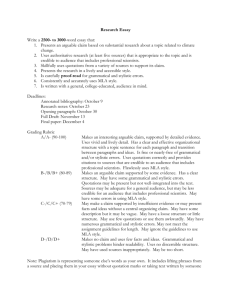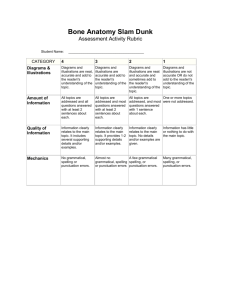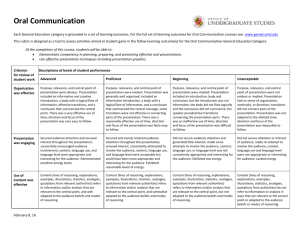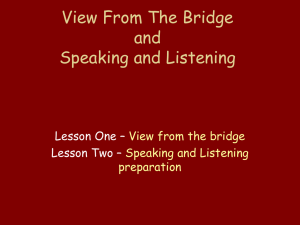Oral communication
advertisement
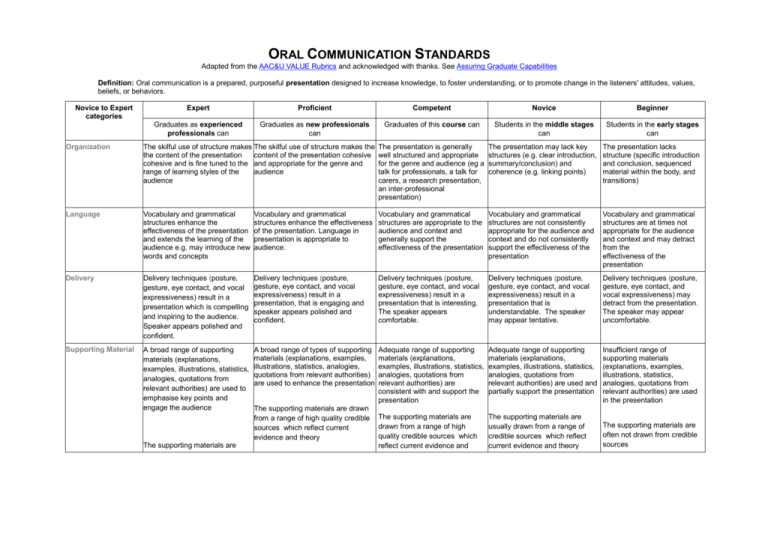
ORAL COMMUNICATION STANDARDS Adapted from the AAC&U VALUE Rubrics and acknowledged with thanks. See Assuring Graduate Capabilities Definition: Oral communication is a prepared, purposeful presentation designed to increase knowledge, to foster understanding, or to promote change in the listeners' attitudes, values, beliefs, or behaviors. Novice to Expert categories Expert Proficient Competent Novice Beginner Graduates as experienced professionals can Graduates as new professionals can Graduates of this course can Students in the middle stages can Students in the early stages can Organization The skilful use of structure makes The skilful use of structure makes the the content of the presentation content of the presentation cohesive cohesive and is fine tuned to the and appropriate for the genre and range of learning styles of the audience audience The presentation is generally well structured and appropriate for the genre and audience (eg a talk for professionals, a talk for carers, a research presentation, an inter-professional presentation) The presentation may lack key structures (e.g. clear introduction, summary/conclusion) and coherence (e.g. linking points) The presentation lacks structure (specific introduction and conclusion, sequenced material within the body, and transitions) Language Vocabulary and grammatical structures enhance the effectiveness of the presentation and extends the learning of the audience e.g. may introduce new words and concepts Vocabulary and grammatical structures enhance the effectiveness of the presentation. Language in presentation is appropriate to audience. Vocabulary and grammatical structures are appropriate to the audience and context and generally support the effectiveness of the presentation Vocabulary and grammatical structures are not consistently appropriate for the audience and context and do not consistently support the effectiveness of the presentation Vocabulary and grammatical structures are at times not appropriate for the audience and context and may detract from the effectiveness of the presentation Delivery Delivery techniques (posture, gesture, eye contact, and vocal expressiveness) result in a presentation which is compelling and inspiring to the audience. Speaker appears polished and confident. Delivery techniques (posture, gesture, eye contact, and vocal expressiveness) result in a presentation, that is engaging and speaker appears polished and confident. Delivery techniques (posture, gesture, eye contact, and vocal expressiveness) result in a presentation that is interesting. The speaker appears comfortable. Delivery techniques (posture, gesture, eye contact, and vocal expressiveness) result in a presentation that is understandable. The speaker may appear tentative. Delivery techniques (posture, gesture, eye contact, and vocal expressiveness) may detract from the presentation. The speaker may appear uncomfortable. Supporting Material A broad range of supporting materials (explanations, examples, illustrations, statistics, analogies, quotations from relevant authorities) are used to emphasise key points and engage the audience A broad range of types of supporting materials (explanations, examples, illustrations, statistics, analogies, quotations from relevant authorities) are used to enhance the presentation Adequate range of supporting materials (explanations, examples, illustrations, statistics, analogies, quotations from relevant authorities) are consistent with and support the presentation Adequate range of supporting materials (explanations, examples, illustrations, statistics, analogies, quotations from relevant authorities) are used and partially support the presentation Insufficient range of supporting materials (explanations, examples, illustrations, statistics, analogies, quotations from relevant authorities) are used in the presentation The supporting materials are drawn from a range of high quality credible sources which reflect current evidence and theory The supporting materials are usually drawn from a range of credible sources which reflect current evidence and theory The supporting materials are drawn from a wide range of high quality credible sources which reflect current evidence and theory The supporting materials are drawn from a range of high quality credible sources which reflect current evidence and theory The supporting materials are often not drawn from credible sources Central Message Exemplars Central message is compelling. Supporting material is used to emphasise key points and engage the audience. Central message is clear. Key points Central message is clear and are emphasised, strongly supported consistent with the supporting and memorable. Supporting material material. is consistent with and adds to the presentation. EXAMPLE A graduating student can prepare and present a talk for carers about communication needs following a stroke. The slides, handouts and any media clips will be organised and contain information at a level appropriate for the audience who will be engaged in the presentation and learn from it Central message is understandable but key points lack emphasis . Supporting material not well integrated into overall message. EXAMPLE A novice student can prepare and present a presentation to peers about EBP for the treatment of a given communication disorder. Effectiveness of the presentation as a whole is limited by: some key structures of the presentation missing, inconsistent use of appropriate delivery techniques and vocabulary. Slides, handouts and media clips are used however are not well organised and or referred to throughout the presentation. Central message can be deduced. Some key points identified. Inconsistent use of supporting materials
